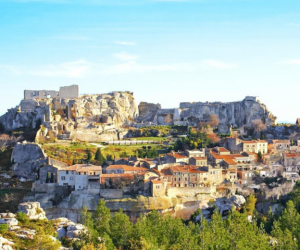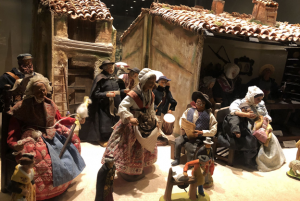Nestled in the rocky area of southern France known as the alpilles, or the little Alps, is the village of Les-Baux-de-Provence. In the valleys below are vineyards making red, white and rosé wines that in recent years have received AOC status under the name of the village.
Photo courtesy of Rue des Vignerons
The village itself is a small gem, a UNESCO world heritage site. It has been occupied for a thousand years and the local people have maintained its medieval character to this day. It was once a fortress and the mighty walls are still there for you to see and walk along. You will see it as you drive up through the valley and you’ll be hard put not to gasp in delight.
The ruined building atop Les Baux is the Château, which was the home of some renegade princes and was torn down, rebuilt, and torn down again as the fortunes of war and politics swayed over the years. By the 19th century Les Baux was pretty much abandoned. Then they discovered an ore nearby that contained aluminum and called it bauxite. The mines are depleted now, but by the time that happened, the tourists had discovered the village.
Today, the 400 or so residents of Les-Baux-de-Provence are joined by thousands of visitors each year. It is a great place to wander through ancient streets, walk the walls and stop for a meal. There are many cafés and restaurants, where you can have typical French meals as well as some gourmet fare.
The remains of the Château are the most visited attraction and you will have to contend with the tour buses that deposit their passengers there. It is worth seeing, if only for the views across the alpilles. The most notable site in the village below is the 12th century Church of St. Vincent. It’s not a magnificent cathedral but rather a simple village church. It’s simplicity belies many notable reasons to visit the church. The windows are modern glass, a gift to the people of Les Baux from Prince Rainier of Monaco. There are also modern murals of Provencal shepherds celebrating Christmas.
Down below the village, hidden amongst the rocks and vineyards, is the Relais & Château Hôtel Baumanière that has merged with the neighboring hotel La Cabro d’Or, a jewel in the repertory of this prestigious hotel chain. One wonderful memory of the three Michelin stars restaurant in this hotel is being served a steak à la moëlle. This is a New York strip topped with beef bone marrow with a small bone filled with marrow on the side. They recommend removing the marrow with a tiny spoon they give you. To this day, we still salivate when we think about this.
It is Christmas that really defines Les Baux. Each year, on Christmas Eve, the villagers form creche vivante (or living creche) around the altar in St. Vincents. The villagers dress in quaint costumes and they lead their farm animals into the recreated manger. It is unlikely that you’ll ever see the ceremony; it’s for the people of the village, not visitors. But you can see the villagers preparing for midnight mass and realize that the waitress and the store clerk you meet are probably members of the touching statement of faith in the church.
Santons. Photo courtesy of lesbauxdeprovence.com.
There’s another Christmas tradition that comes from Les Baux. Many people in America and elsewhere decorate their homes with miniature houses and people made of porcelain. These are called santons. Perhaps the people who treasure these delicate pieces don’t realize it, but the village they’re recreating is in fact Les-Baux-de-Provence. There’s even a museum of santons there. Yet another reason to visit Les Baux when you’re wine tasting is to collect some of these miniatures from the place where they originated.

